EDIT: Updated thanks to @daroczig's lovely answer below. However, test 2 still feels like it takes longer than test 1 which is what I'm wondering about.
UPDATE: On second reading, @daroczig's answer does explain away my confusion -- the issue was due to me not properly thinking out the system.time(expr) line of code.
I wanted to make a version of the system.time function which would be a bit more informative for myself in terms of understanding run-to-run time fluctuations:
system.time.summary <- function(N, expr) {
t.mat <- replicate(N, system.time(expr))
as.data.frame(apply(t.mat[1:3,], 1, summary))
}
However the problem is, in the self contained code below, test.2 feels like it is taking longer to do than test.1 (and I've run them several times to check), even though the code is pretty much exactly the same (test.1 uses a wrapper function, whereas test.2 is just the raw code)
# set up number of runs
N <- 100
# test 1
system.time.summary(N, (1:1e8)^2 + 1)
user.self sys.self elapsed
Min. 0.000 0.000 0.000
1st Qu. 0.000 0.000 0.000
Median 0.000 0.000 0.000
Mean 0.058 0.031 0.089
3rd Qu. 0.000 0.000 0.000
Max. 0.580 0.310 0.890
# test 2
t.mat = replicate(N, system.time((1:1e8)^2 + 1))
as.data.frame(apply(t.mat[1:3,], 1, summary))
user.self sys.self elapsed
Min. 0.630 0.120 0.860
1st Qu. 0.665 0.170 0.880
Median 0.695 0.195 0.880
Mean 0.692 0.196 0.882
3rd Qu. 0.715 0.225 0.890
Max. 0.760 0.260 0.900
I hope I explained that OK! It could be that it's currently Monday morning, but this is confusing me...
My system:
# Windows Server 2008 R2
> sessionInfo()
R version 2.12.0 (2010-10-15)
Platform: x86_64-pc-mingw32/x64 (64-bit)
